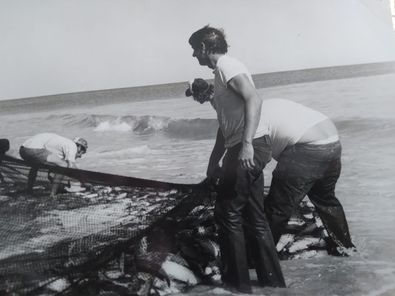Seine Fishing on Topsail
- Carol Ann Ross

- Dec 3, 2021
- 4 min read
Updated: Oct 6, 2022
Of course Topsail Island has long been associated with fishing, the natural rock formations there make the island a good spot for it. People come here from all kinds of places to surf fish and to fish from the piers. Most people know that the island was once home to nine fishing piers: McKees, Paradise, Ocean City, Scotch Bonnet, Barnacle Bills, Surf City, Dolphin, Jolly Roger and the Sound Pier. Now we are down to only three.
But did you know that there was a time when scads of people used to flock to our little sand bar not to fish from a pier or even to surf fish, but to use a seine. The seine has been around for centuries. There is even mention of seine fishing in the Bible. So what is a seine?
A seine is a huge net manned by people-operated and pulled by people. It has had a long standing tradition, in this neck of the woods, for decades and as far back as most folks around here can remember. Seine fishing was how many families in this area made their living.
In the fall and spring of each year, fish migrate north to south or south to north. Bigger fish follow smaller fish for food. So you could say that seine fishing was a semi-annual event. It’s safe to say that seine fishing was, at one time, a tradition-a family tradition, because extended families, along with friends, would gather together at that time of the year, and haul in millions of pounds of fish to be sold to fish markets in Wilmington.
Long before there was a bridge and before there was an Intracoastal Waterway, men brought dories over to the island. Sometimes they were kept sheltered in a ramshackle building on a wooden trailer, but when preparing for use, a dory would be rolled as close to the ocean as possible.
Each man who came to be part of the work had a task, some worked the seine, some were oarsmen and some were spotters.
The spotter kept lookout for the fish north of the launch site (in the fall) keeping his eyes peeled for the huge black cloud (school of fish) in the water that moved southward. When the spotter waved his hand, it meant, “get ready,” that meant that the seine needed to be boated (put in the boat). If he took off his hat and waved it about, it meant there were a lot of fish (usually mullet). If he waved his coat about, it meant the school of fish was very large. If he ran back and forth from the shore to the dunes, it meant that the school was enormous. (Try running back and forth from the dunes to the shore and see how long you last).
Once seeing the signal from the spotter, and as soon as the seine was boated, the dory would be lifted from the trailer by poles that were then threaded through ropes affixed to the gunwales. It took fifteen or so men to lift the heavy structure from the trailer into the water and then to move past the breakers. After hoisting themselves into the boat, the race against time and nature began.
There were no electric wenches or pulleys available to those men, no outboard motors, so everything was done by sheer brute strength. I was told by someone that once these men dipped their oars in the water it truly was as if they had a power motor-the boat took off with immense speed.
The job of those working the seine was very important. While boating the seine they had to be sure not to snag it on the gunwales. They had to make sure that it would lead out into the water to surround the school of fish, without bunching. Both cork and lead lines were led from the stern into the ocean at the same time, with the lead line sinking and cork line floating, so that the net wrapped the fish up so none or very few could escape.
As the dory neared the shore with its catch, waves would crash over the stern and fish would gasp for air, jumping erratically. Fishermen held the lead line down to keep any from escaping and held the cork line up for the same reason. As the dory was beached, everyone jumped from the boat and they, along with those waiting on shore, pulled on the heavy fish laden net.
Back then there were no pick-up trucks on the island, no roads, so each person who participated in the seine fishing had to supply his own barrel or sack-no sack or barrel, no fish. One had to work if he wanted to eat.
Fish were salted for preservation and taken home or loaded into carts on the mainland and then taken to Wilmington. In years to come these fish would be sold to houses in Hampstead or Sneads Ferry.
As you see, life was not easy back then. Everyone worked hard, even the women and children. Everyone was self-sufficient. But then that was a different time. There was a different way of living and thinking, perhaps.
Sometimes I throw a line in the water and wait, knowing I know how to feed myself, and then other times I do my fishing at Thomas Seafood.
Part of Issue 4:







